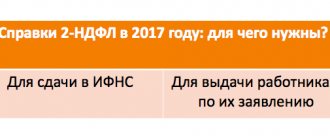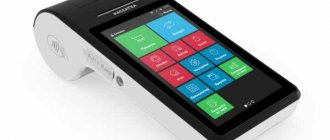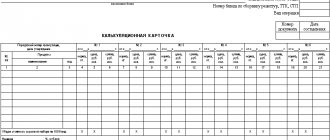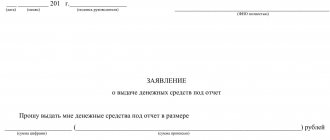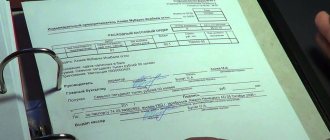According to the laws of the Russian Federation, now all cash registers are online cash registers that connect to the Internet and transmit data to the tax office through the OFD. To learn more about the new cash registers, read articles about them on our blog:
- Who is switching to online cash registers in 2021, and who in 2021
- What has changed in working with online cash registers: new laws
There are many online cash registers on the market. Among them there are also autonomous cash registers - they are also called total cash registers or autonomous cash registers - which are cheaper than others. And although they still comply with the requirements of the law, autonomous vehicles have limited functionality and very few opportunities for the entrepreneur.
What kind of cash registers are there, what are autonomous cash registers and which online cash register to choose for your business so as not to buy a new one in a few months - we’ll talk about this in our article.
More details:
- Types of online cash registers
- Fiscal registrars
- Autonomous cash registers
- Monoblocks
- POS systems
- Cash programs
Fiscal registrars
What kind of cash registers are these?
Fiscal registrars are online cash registers that are controlled by an external cash register program. They are chosen when the business owner has already purchased the necessary cash register software for his business area. And in order to sell legally, he only needs a printer for printing checks - which not only prints, but also sends these checks to the tax office through the OFD. This is the fiscal registrar.
What can they do?
Fiscal officers have limited functionality. These are cash registers that do not have buttons or a screen - they work with a device that has a cash register program. They know how to print and send checks under 54-FZ using a fiscal drive. But a signal about any actions is sent to the fiscal registrar by the cash register program, which is installed on a computer, laptop or other device.
So it turns out that the cashier works with this program to make sales. And already in the registrar itself a fiscal drive is installed, which gives it the ability to store sales data, print receipts and send them to the tax office through the OFD.
Fiscal recorders have different printing speeds and are designed for different loads. The advantage is that there is plenty to choose from - you can find the right registrar for your business. They can be divided into two areas of application: for chain retail or restaurants and for small retail or service industries.
In fiscal offices for large networks, the printing speed is many times faster - for example, Wiki Print 80 plus F prints 300 mm and 10 positions per second. Also, such fiscal registrars have a check cutter. All this is needed to quickly serve customers and reduce queues. As a rule, these fiscal officers print receipts on a wide 80 mm ribbon - it displays a large number of goods sold. But it’s not just supermarkets who need this. This is also useful where the receipt contains advertising information: for example, restaurants or brand stores.
Fiscal books for small retail and service industries are the same, but without a receipt cutter and with a lower printing speed - and their receipts are slightly narrower. For example, Wiki Print 57 F prints 100 mm and 5 positions per second. But all this is enough to sell goods and services in places where there is not a large flow of customers.
How much are
The average cost of fiscal files with a fiscal accumulator for 15 months is from 15,000 rubles to 40,000 rubles. It depends on the registrar’s printing speed and the availability of a receipt cutter.
Where not to use
Fiscal registrars are not suitable for courier deliveries, trading in markets, as well as for points where there is little space - for example, stalls. They are not suitable for mobile trading, because they work from a power outlet and Wi-Fi or Internet cable, and for small retail outlets, because a laptop, computer or device with a cash register program takes up a lot of space.
Free cash register program Dreamkas Start and Fiscal registrar Wiki Print 57 F
Buy with a 30% discount until September 1, 2021.
Where is an offline online cash register used?
Due to their compact size, such online cash registers are used in small retail outlets, courier services, taxis and other small locations.
Additionally, it should be noted that stand-alone cash register machines have a slow receipt printing speed, which makes it intended for small trade.
Important! For high-traffic trade, a stand-alone online cash register is not suitable, as it will slow down customer service.
It will also not be possible to keep inventory records using such a cash register, since this option works without a computer on which a program for calculating balances must be installed.
In cases where it is necessary to maintain inventory records or automate a point of sale, you should choose smart terminals or fiscal registrars.
Autonomous cash registers
What kind of cash registers are these?
In the understanding of many market participants, an autonomous system is a convenient push-button cash register that does not require connection to a computer, runs on a battery and has a built-in modem. She doesn't need a power outlet or Wi-Fi.
Alas, this is practically its only advantage. Because, first of all, an autonomous system is a totaling cash register, which is not designed to work with a database of goods and does not help a business grow.
What can they do?
Autonomous devices are better than fiscal registrars only in a few points.
Built-in user interface.
Unlike fiscal recorders, autonomous machines have a screen and buttons. All cash transactions can be performed using automated machines.
Autonomy.
If a store or other point is located in a place where there are interruptions in electricity or the Internet, you can still work with such a cash register and sell legally - the autonomous units have an Internet modem and a battery, and they do not need Wi-Fi or wired Internet.
Price.
Autonomous cash registers are one of the most budget-friendly solutions on the market. If you just need to meet the requirements of the new reform and send checks to the tax office through the OFD, you can save money and buy such a device.
Simplicity for micro-businesses.
If the outlet sells up to 10 products or one service, no new products are launched, no items are added, and the business does not require automation and development, sales analytics - an autonomous system will do.
What can't they do?
In general, autonomous machines have one big disadvantage - this cash register is pre-programmed in such a way that you cannot make any changes to it yourself. This requires the help of an engineer or a trip to a service center: this costs money. It is difficult to modernize such a cash register - and there are constantly changes in the law, and businesses need to adapt to them. And the business itself usually does not stand still and develops. To understand, we can consider this whole story with autonomous vehicles using the example of game consoles.
There are modern consoles - those that are great to play alone or with a group. They are updated, have many opportunities for players, are convenient and simple, and are synchronized with the Internet.
And there are old consoles - those into which game cartridges are inserted, which have very limited functionality and nothing can be done with the hardware. These are autonomous vehicles. They exist somewhere very far from progress - and this despite the fact that they have been produced for the last few years.
To protect the reader from an ineffective purchase, we will tell you in more detail about the disadvantages of autonomous machines for business owners, accountants and cashiers.
Little memory.
The autonomous unit can be loaded with from 30 to 30,000 products, depending on the specific cash register. It may seem that this is enough, but for popular stores with traffic from 100 customers per day, the base grows and changes very quickly. Some products go out of stock, others appear. All these steps fill and wear out the battery's limited memory.
And when working with marked goods, you will need to store and transmit additional information about each unit of goods sold and all its names. For example, 300 titles may be reduced to 100 due to lack of memory.
Small screen.
Why it's bad: It's just inconvenient. The long product name does not fit on the screen. For example, the store sells “Vkusnokroshkino Strawberry with jelly” and “Vkusnokroshkino Strawberry with chocolate” cookies. Only the word “Vkusnokroshkino” will be displayed on the screen, and it is not clear what kind of cookie is being made. The cashier constantly has to strain and read carefully to understand what is written on the screen and not make a mistake. When there is a line in the store, this delays customers even more.
Inconvenient loading of goods.
You can load goods directly at the checkout, but only through a special table of codes - which is not at all easy. Plus, to load goods through a computer, you need to close the shift at the checkout, connect it to the computer and use a special program into which goods are entered manually through a table. All names must be adjusted to the format of this program.
But everything loads slowly - from half an hour to several hours. The entire time the cash register is connected to the computer, it does not work. The shift is closed, business is at a standstill. And in any case, to work with goods, the cash register must be connected to a computer or laptop - it is often impossible to load goods remotely.
Also, there are very few fields needed for goods in the autonomy. When you need to add brands, expiration dates, sizes or type of goods and services - all this cannot be done offline.
Work according to the amount.
Due to the almost impossible loading of goods, such checkouts often operate in total mode - just like a calculator. When cash registers work by amount, they do not identify the goods and do not write them off from the database. In total mode, the cash register doesn’t care what to sell: a can of corn or sausage. All that is included in the receipt is the cost of the goods.
Due to the fact that in the sum mode it is not possible to track the movement of goods, the business suffers losses and risks. So, if the goods are not at the checkout, the store owner will not be able to guarantee that the cashier sold it and did not take it home or sell it at exorbitant prices himself. Inventory with total accounting is simply impossible: unless from the cashier’s notebook. Plus, when the cash register works by amount, it cannot work with product labeling - which is what becomes mandatory in 2021. And from 2021, it is mandatory to enter the names of all goods - not just labeled ones.
Inconvenient equipment connection.
Some autonomous vehicles do not work with additional equipment at all. Others have USB ports, but you can’t plug in any model you like there either. Still others have one or two ports, and you cannot, for example, use a bank terminal and a barcode scanner at the same time. Some manufacturers produce additional devices for their autonomous units—they are also called “hubs.” They cost two to three times more than the cash register - and you can already connect equipment to them. In any case, it turns out to be expensive and inconvenient.
Inability to deal with stocks.
A complex operation is a task that is done at the checkout during a sale - for example, calculating discounts, creating promotions, searching for goods. Such operations are not available on autonomous mode. But manual discounts are available. But this means that all promotions at the checkout depend on whether the seller remembers about them and whether he makes discounts when necessary.
No business automation.
Autonomy is suitable only for those who have few product items and the database for which is not updated, and who have few settlements with customers. In a stand-alone mode, you cannot set up accounting for goods, work with accounting programs, online stores, collect sales statistics, reports and analyze your business.
Cash desk F automates business and covers all legal issues with one purchase
A modern, fully functional push-button cash register, a service for sales analytics, a fiscal storage device and 15 months of CRF included.
How much are
The average cost of an autonomous vehicle with a fiscal storage for 15 months is from 15,000 rubles to 20,000 rubles.
Where not to use
Business with more than 30 types of goods or services.
To summarize everything that has been said above: on a stand-alone system it is difficult to punch through goods and enter them into the database, connect services and additional equipment - for example, a barcode scanner. It is also difficult to update the autonomy.
EGAIS.
Only a few manufacturers make vending machines that can sell strong alcohol. But even here there are difficulties.
Their autonomous vehicles do not support connecting a 2D scanner, identifying goods and installing UTM - and all this is mandatory for EGAIS. When users realize that the cash register cannot work with EGAIS, manufacturers offer to buy an additional computer for the autonomous system. Already with it, it is possible to connect a scanner, send, compare and record data for Unified State Automated Information System, and drink alcohol. This purchase costs time and money.
Labeling of goods.
To combat counterfeiting, the government is introducing global product labeling. We wrote about it on our blog.
The most important thing that labeling requires is the presence of the names of all labeled goods that are in the store, at the checkout. If you are selling a labeled product, you cannot sell an abstract product for 100 rubles - you must sell a specific name and read the unique labeling code.
It is not yet known whether autonomous vehicles with product labeling will work. Perhaps through additional paid services or devices - like with EGAIS. Even if autonomous vehicles can sell labeled goods, doing so will be difficult and inconvenient - and here’s why:
- Loading goods.
As mentioned above, loading goods onto autonomous vehicles is difficult.
But you will have to if the store sells labeled goods. You will need to enter each item manually, close your shift to load goods at the checkout, and double-check everything. Barcode Scanner.
Not all autonomous vehicles work with a scanner, but it is required to sell labeled goods.
System for receiving invoices.
It is not clear where a business owner can work with invoices: autonomous machines do not have such services implemented.
Product identification
And there is also a mandatory point for EGAIS and labeling - this is the identification of the product. Let's look at examples.
How are goods identified at online checkouts?
For example, an entrepreneur has a store, a cash register from Dreamkas and a Dreamkas Office. While the cashier is working in the store, a product arrives at the office - let it be 15 types of cookies. The goods arrive with a paper invoice.
To add these products, you need to connect a barcode scanner to your computer or laptop, click “Add Product” in the Dreamkas Account and start scanning the codes on the invoice. The account immediately finds the product - all that remains is to select its type, set the price and VAT percentage. And so with every product.
This is done very quickly, and within a minute the goods are already at the checkout. The cashier does not need to add anything himself.
If the goods come not to the office, but to a store where there is no computer and there is only a cash register. In this case, the cashier takes a barcode scanner, scans the codes at the checkout - and the device itself finds the name of the product in the product cloud. When the cashier sells the product, it will immediately appear in the Dreamcas Office.
How is a product identified on autonomous vehicles?
The product arrives at the store with a paper invoice. The cashier needs to take this invoice, sit down at the computer, connect the cash register to it and enter the goods manually. This is usually done in the evening after the store closes because the shift is closed while goods are being loaded. This way you can sell goods not by amount, but by name.
If a store wants to sell goods by amount, there is no problem. But then it is not clear what exactly is being sold, and it is not possible to conduct a proper inventory. The seller talks about the goods sold in a notebook - and only on the basis of this an order is made, which is very unreliable.
Remember
If you purchase a stand-alone cash register, you will need to purchase an additional computer to record goods and connect a scanner. This is more difficult and more expensive than buying an online cash register that is ready for all changes in the law.
If a store sells counterfeit goods and does not take into account goods with mandatory labeling, there will be sanctions and fines.
In what areas is mobile cash register used?
The mobile device presented for this purpose is convenient and can work anywhere in the world with Internet access. Thanks to this, a portable cash register is used in the following areas:
- small business areas without working space;
- outbound trade and provision of services at the consumer’s home or from a vehicle;
- Express delivery.
Portable online cash registers are designed for a small number of transactions per unit of time due to limited battery power, a small volume of issued checks and an underestimated technical resource. However, the average cost of such access products is even for people who are just starting their business and are not ready for large investments. This causes the rapid growth in popularity of the equipment.
Mobile-type online cash registers are characterized by the presence of the necessary options. All of them allow you to do business completely within the framework of current legislation and instantly generate and send reports required by the tax service.
The devices perform the following functions:
- generation of information on sales and services provided in a fiscal storage device, which can be changed as needed;
- connecting the device to a personal computer or mobile gadget for the purpose of input/output/transfer of information;
- wireless transmission of information to the Federal Tax Service;
- accepting non-cash payments using bank cards.
Expert opinion
Kirill
Cashier specialist
Ask a Question
Modern equipment consists only of high-quality components, a color or black-and-white display of optimal size. This feature allows the devices to operate for many years without loss of quality, and the image on the cash register screen will be clearly visible to consumers of goods or services.
Monoblocks
What kind of cash registers are these?
These are online cash registers for small and medium-sized businesses. These cash registers have a built-in receipt printer, cash register program, cashier screen, keys or touch screen. All operations can be performed from them - a computer is not required. Therefore, such devices are a full-fledged cashier’s workplace.
What can they do?
Monoblocks work with additional equipment and services, are easily updated, allow you to carry out complex operations at the checkout and analyze sales. They also adapt to changes in the law.
But all monoblocks are different. Some work with EGAIS and sell strong alcohol, others integrate with online stores. The easiest way is to use these cash desks by business area.
Cash registers for restaurants
Large screen touch cash registers are suitable for cafes and restaurants. This screen allows you to quickly enter items into a receipt from product tiles and issue bills - these are what waiters bring to customers in the form of an invoice. As a rule, with the help of such cash registers you can indicate table and order numbers on the receipt. And the laundry itself can be transferred to the kitchen to the cooks.
Wiki cash registers for restaurants and cafes
Allows you to work with gloves, quickly add dishes and drinks to your receipt, sort orders and analyze sales.
Cash registers for online trading
Cash registers for online trading operate without the participation of a cashier. And while many of them have a screen and user interface, they automatically close and open shifts, integrate with a CMS to manage your online store, and help you comply with all legal requirements.
Cash desk F for online stores
Suitable for online stores with and without a pick-up point. The price already includes a CRF for 15 months. Works with popular CMS systems.
Cash desks for couriers and trade in markets
Everything is simple here: these are mobile cash registers that operate on battery power and do not require wired Internet - there is a slot for a SIM card inside. Sellers in markets and villages, couriers and stall owners can work with such devices.
These cash registers should not be confused with automated total cash registers: mobile cash registers, like other online cash registers, work with product names and are synchronized with their database. They allow the cashier to sell quickly, and the business owner to analyze sales. Autonomous devices also run on batteries and do not require wired Internet, but they are difficult to work with.
Cash registers for small retail
Cash desks that are suitable for trading in stores and selling services are the most in the register. These cash registers are push-button and touch-sensitive. With touch checkouts, you can simply add items to your receipt and conveniently sell items without barcodes. But push-button ones are more common for cashiers and salespeople.
Some of these cash registers work with EGAIS - they can sell strong alcohol. Others know how to work with labeled products - for example, tobacco, which by law must be labeled as of March 1, 2021. Our solutions also have many integrations and a free service for sales analytics and business automation - Dreamkas Cabinet.
How much are
The average cost of monoblocks with a fiscal drive for 15 months is from 25,000 rubles to 35,000 rubles.
Where not to use
Monoblocks cannot cope with a large flow of customers - such as in a large retail chain.
Which cash register to choose depending on your business
The choice of cash registers is very large, some of them are very simple, others are packed with many functions and capabilities. Therefore, choosing a cash register for a business should be done carefully - in order to choose what you need and not overpay for unnecessary functions.
For courier delivery services.
Here the main parameter will be the long operating time without recharging and the weight of the battery, and the number of product ranges, software updates and the ability to connect various additional devices are not important. The best option in this case would be devices similar to Atol-90F, Mercury 115F, and Shtrikh-Mpey-F.
Did you know? Although most people, when they hear the words electronic computer or computer, think exclusively of a computer, a cash register machine is also one of them.
For online stores.
A stationary smart terminal, such as the Evotor 7.2, will be suitable, which will issue receipts behind the counter. For couriers delivering goods to customers, you can purchase autonomous devices “Atol-90F”, “Mercury 115F”, “Shtrikh-Mpey-F”.
For small and medium-sized stores.
Small shops and kiosks, sellers at markets and on the road will also appreciate the convenience of working with small autonomous cash registers. For stores with a medium area and a range of more than 100 items, Evotor and Viki terminals are suitable.
For supermarkets.
A large store and supermarket will require full-fledged fiscal recorders with a connection to a computer or tablet and cash drawers. Viki Print 57 Plus, Atol-55F, and Shtrikh-Light-01-F have proven themselves well.
The cash register market is quite wide, with a large number of models and brands represented. In order not to make a mistake when choosing a cash register, you should clearly understand the current needs and business development strategy. This approach will help you choose a cash register that will serve for a long time and will comply with legal requirements.
POS systems
What kind of cash registers are these?
This is a kit for any large chains - for example, hypermarkets. They last a long time, work smoothly and quickly serve customers. Despite the configuration and name, the POS system is an ordinary cash register, only for large retail and a large flow of customers.
What can they do?
Typically, such a system has a system unit and keyboard, a cashier monitor and a buyer display, a cash drawer and a fiscal recorder. They know how to print and send checks to the tax office. They work using a cash register program and a cash server.
The cash register program is installed at the checkout itself, it takes into account the goods, helps the cashier accept payments and calculate the cost.
The cash server automates the work of the store. It helps to load goods and prices onto the checkout, monitors the printing of price tags, closing and opening of shifts, adding promotions, sales and discounts. The server collects analytics and statistics on all sales from all cash registers and helps manage them remotely.
The POS system is designed for high load: up to 600 checks per day. Manufacturers of such systems sell spare parts for them even after they have been discontinued. They are expensive, but have the lowest cost of ownership over a period of 5 years.
Buying a POS system is a good investment for large retailers. In addition, it is very flexible: if there are changes in the law, it is easy to update it and make it work according to the new rules.
How much are
The average cost of POS systems is from 100,000 rubles to 150,000 rubles.
Where not to use
The POS system works great, but is expensive. For retail and services, there are other, more budget-friendly solutions on the market. Therefore, we recommend using the system only for large retail.
What is a mobile online cash register?
An autonomous mobile cash register is a compact device that can be easily packed into a bag, case or backpack in order to transfer this product to any convenient place. This is a convenient, practical and affordable way for beginning entrepreneurs to work with online cash register systems.
There are devices on the market without a fiscal drive. Their cost is somewhat lower than analogues where this element is present, however, such products require careful configuration. In most cases, a professional is invited for this purpose, whose services are paid according to his tariff. Please note that the fiscal drive is purchased only from the fiscal data operator.
Expert opinion
Irina Smirnova
Online checkout expert
Ask a Question
The cost of mobile online cash registers varies from 25 to 30 thousand rubles. This is considered an acceptable price for business representatives. You can also purchase a mobile cash register that accepts plastic cards for making payments to consumers via a bank card. This increases the convenience of providing goods and services several times for both the entrepreneur and the consumer.
The fiscal sensor in such models of devices is built into the body of the product and is an integral part. If it is necessary to install a new sensor (for example, due to failure), the device must be re-registered with the tax service and the technical service center. If all the presented activities are successful, the individual entrepreneur can begin his work, being in the legal field.
There is also the possibility of installing specialized software on a mobile gadget. With its help, the cashier enters information about the purchase via a smartphone or tablet and generates a receipt electronically. To print this document, an external fiscal recorder is used that is connected to a mobile device.
Cash programs
What kind of cash registers are these?
The cash register program is the brain of the online cash register, its integral essence. She guides the cashier: she tells him what he must do to sell the goods and get a check. This saves the cashier from mistakes and helps him do everything quickly and correctly. It also generates checks, sends signals about what needs to be printed and what data to write down.
What can they do?
The cash register program is installed on a laptop or built into the software of the cash register itself. It has a lot of possibilities - every user and business owner chooses what he needs. All programs are different, but the main thing is that they can:
- generate checks,
- send data to the fiscal drive,
- send checks to OFD,
- update,
- work with goods.
Help the cashier work. They manage the opening and closing of shifts, generate fiscal documents, and set prices. Most of them know how to store a product database, search for articles, work with third-party services for business automation, and integrate with inventory accounting systems.
They help to punch through goods without a barcode, calculate change, conduct manual and automatic promotions and discounts, work with advances, prepayments, and returns. They work with cash and non-cash payments.
Review of models that work offline
The retail network offers quite a large number of AKKMs of various brands. Most of them are comparable in their parameters and have quite a few differences. You can highlight and consider some of the brands that are the most popular and in demand.
"ATOL"
Autonomous cash desks "ATOL" are intended for small businesses with a small and constant number of product items. The advantage of such cash registers is their light weight and compact size. They are equipped with batteries that allow you to work without recharging for up to 8 hours.
ATOL cash desks allow you to:
- establish simple percentage and amount discounts on goods;
- carry out non-cash payments;
- program up to 100 products, up to 8 departments and sections, up to 5 tax rates;
- reverse sales and issue a return of goods;
- deposit and withdraw money from the cash register;
- display reports with and without blanking;
- generate simple reports: by section, by cashier, by hour, by quantity;
- configure the cash register using software;
- connect a barcode scanner.
